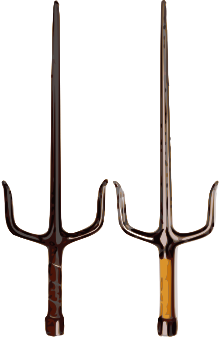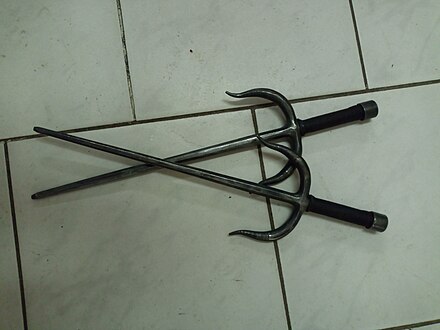| Revision as of 04:36, 19 October 2024 edit67.146.106.187 (talk) →History← Previous edit | Revision as of 22:27, 20 October 2024 edit undo84.246.205.232 (talk) Clarified geographic origin. The article contradicted itself, as there are a number of sources for the Sai in Asia that predate its use in Okinawa.Next edit → | ||
| Line 2: | Line 2: | ||
| {{Short description|Pointed melee weapon from Okinawa}} | {{Short description|Pointed melee weapon from Okinawa}} | ||
| ] | ] | ||
| The '''''sai''''' (]: ], {{lit|hairpin}}; ]: ], {{lit|iron ruler}}) is a pointed ] from ]. It is historically utilized in martial arts such as ] and southern Chinese martial arts, and has been absorbed into the curriculum of many modern martial arts. The weapon is primarily used for stabbing, striking, parrying and disarming opponents. The ''sai'' consists of a pointed metal main prong, that projects from a one-handed handle, two shorter metal side prongs, which project from the opposite sides of the base of the main prong and point in the same direction as it, and a blunt metal pommel fixed to the bottom end of the handle. ] spread to Japan in the early 20th Century alongside ], and it came to international attention when ] became popular in the mid-20th Century. | The '''''sai''''' (]: ], {{lit|hairpin}}; ]: ], {{lit|iron ruler}}) is a pointed ] from ]. It is historically utilized in martial arts such as ] and southern Chinese martial arts, and has been absorbed into the curriculum of many modern martial arts. The weapon is primarily used for stabbing, striking, parrying and disarming opponents. The ''sai'' consists of a pointed metal main prong, that projects from a one-handed handle, two shorter metal side prongs, which project from the opposite sides of the base of the main prong and point in the same direction as it, and a blunt metal pommel fixed to the bottom end of the handle. ] spread to Japan in the early 20th Century alongside ], and it came to international attention when ] became popular in the mid-20th Century. | ||
| ==History== | ==History== | ||
Revision as of 22:27, 20 October 2024
Pointed melee weapon from Okinawa
The sai (Japanese: 釵, lit. 'hairpin'; Chinese: 鐵尺, lit. 'iron ruler') is a pointed melee weapon from Asia. It is historically utilized in martial arts such as Okinawan kobudō and southern Chinese martial arts, and has been absorbed into the curriculum of many modern martial arts. The weapon is primarily used for stabbing, striking, parrying and disarming opponents. The sai consists of a pointed metal main prong, that projects from a one-handed handle, two shorter metal side prongs, which project from the opposite sides of the base of the main prong and point in the same direction as it, and a blunt metal pommel fixed to the bottom end of the handle. Okinawan kobudō spread to Japan in the early 20th Century alongside Karate, and it came to international attention when martial arts became popular in the mid-20th Century.
History

Before its use in Okinawa, similar weapons were already being used in other Asian countries including India, Thailand, China, Vietnam, Malaysia, and Indonesia. The basic concept of the sai may have been brought to Okinawa from one or several of these places over time. Some sources theorize that the weapon may be based on the Indian trisula, an ancient Hindu-Buddhist symbol that may have spread along with Hinduism and Buddhism into South-East Asia. The word trisula itself can refer to either a long or short-handled trident.
In Okinawa the sai was used by the domestic police (ufuchiku) to arrest criminals and for crowd control. Use of the sai in Okinawan kobudō was approved in 1668 by Moto Chohei, an Okinawan prince.
Japan had a similar weapon, the jitte, which was originally used as a blunt weapon by guards in the Shogun's palace, and was subsequently issued to senior officials as a badge of office. Edo period examples of the jitte typically have only a single hook. The relationship between the sai and jitte is unclear.
Parts

- Monouchi, the metal main prong of the sai, that is either round or faceted.
- Saki, the sharp point of the main prong.
- Yoku, the two shorter metal side prongs of the sai, which usually point in the same direction as the main prong, with the exception of the manji sai developed by Taira Shinken, which has the direction of one of the side prongs reversed, causing the weapon to be reminiscent of a swastika (manji).

- Tsume, the sharp point of the two side prongs.
- Moto, the center point between the two side prongs.
- Tsuka, the one-handed handle of the sai, which is usually wrapped with different materials or given different treatments to add more grip to it.
- Tsukagashira, the blunt metal pommel of the sai.
Technique

The sai is a weapon typically wielded in pairs, with one in each hand. In modern Okinawan Kobudo, five kata (choreographed patterns of movements in martial arts) are commonly taught, including two kihon kata.
The utility of the sai is given away by its distinctive trident-like shape. It is a weapon primarily used for fast stabbing and striking, but being very versatile, it has many other uses as well. These include a variety of blocks, parries and captures against attackers from all directions and height levels. Use of the sharp points, the main prong and the pommel is emphasized, as well as rapid grip changes for multiple fast stabs and strikes.
One technique commonly depicted is to use of one of the sai's side prongs to entrap an opponents weapon and then disarm them of it. Some variations of the sai have the two side prongs pointing inwards towards the main prong to facilitate this maneuver. While this does not completely immobilize the attacker, it encumbers them in close quarters.
Because there is no morphological plural in Japanese, the word "sai" refers to either a single weapon or multiple. Nicho sai refers to a kata that uses two sai, while sancho sai kata refers to kata using three sai.
See also
References
- ^ Draeger, Donn F.; Robert W. Smith (1969). Asian Fighting Arts. Tokyo: Kodansha. OCLC 812370873. Reprint: Comprehensive Asian Fighting Arts (registration required). New York; Tokyo: Kodansha International. ISBN 978-0-87011-436-6.
- "Everything You Need to Know About the Sai Weapon". Technology.org. 2019-05-24. Retrieved 2023-02-02.
- "The Trishula". Ancient-Symbols.com. Retrieved 2023-02-02.
- Gosula, Poojitha Reddy (2021). The Girl Who Reads Her Past Six Lives: She Is the Army-Chief (eBook ed.). Chennai: Notion Press. p. 250. ISBN 9781648998782.
- Kanenori Sakon Matsuo (2005). The Secret Royal Martial Arts of Ryukyu. Translated by Joe Swift. Norderstedt, Germany: Books on Demand. p. 81. ISBN 9783833419935. OCLC 778744684.
- Graham, Dr. Leslie M. (August 1993). "The Sai: Okinawan Karate's Treasured Trident". Black Belt. Vol. 31, no. 8. p. 51. ISSN 0277-3066.
Further reading
- Demura, Fumio (1974). Sai: Karate Weapon of Self-Defense. Burbank, Calif.: Ohara B Publications. ISBN 0897500105. OCLC 1103415.
External links
| Okinawan kobudō | |
|---|---|
| Weapons | |
| Styles |
|
| Comparison of styles | |
| Types of Chinese weaponry | |||||
|---|---|---|---|---|---|
| Swords |
| ||||
| Polearms |
| ||||
| Roped/chained | |||||
| Projectile |
| ||||
| Handheld |
| ||||
| Protection |
| ||||
| Major lists | |||||